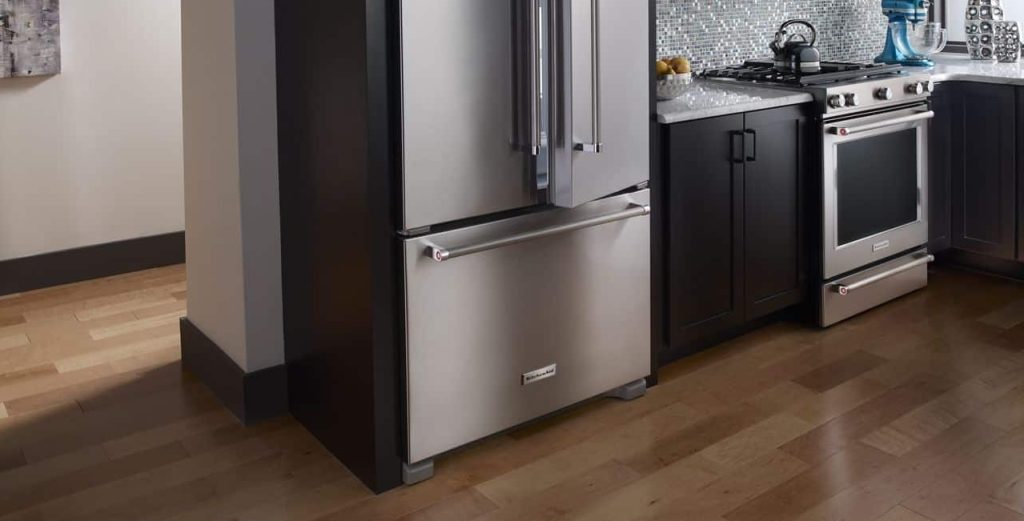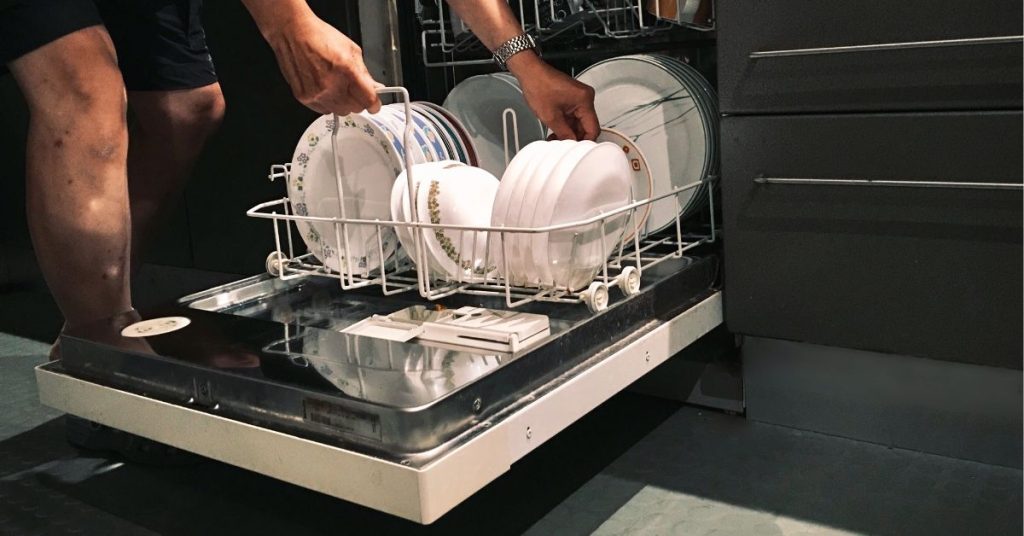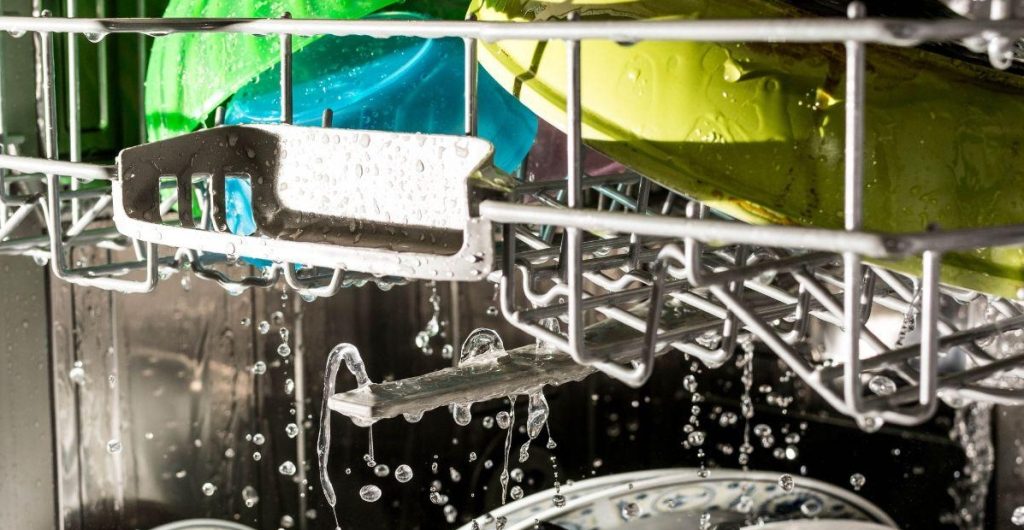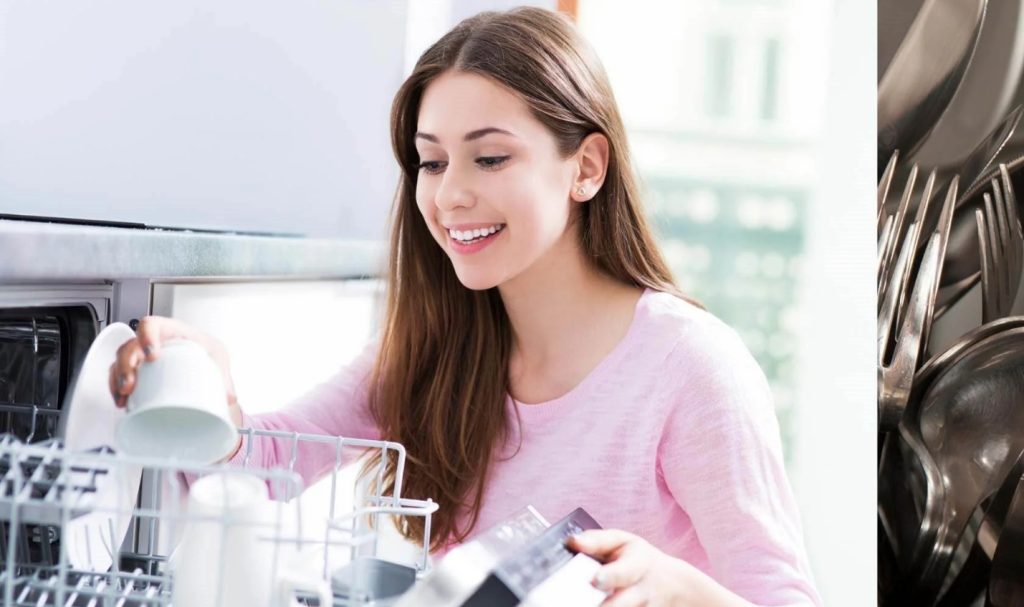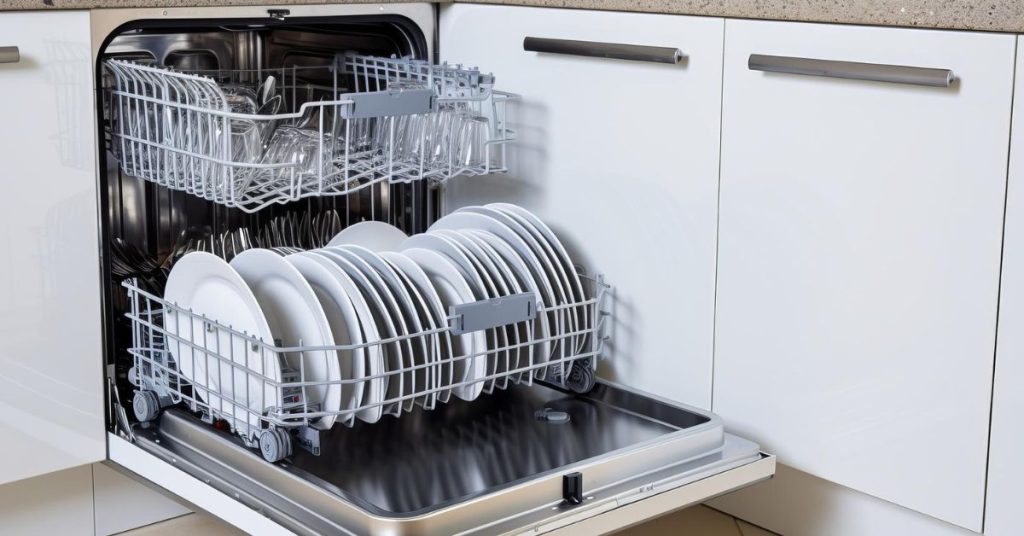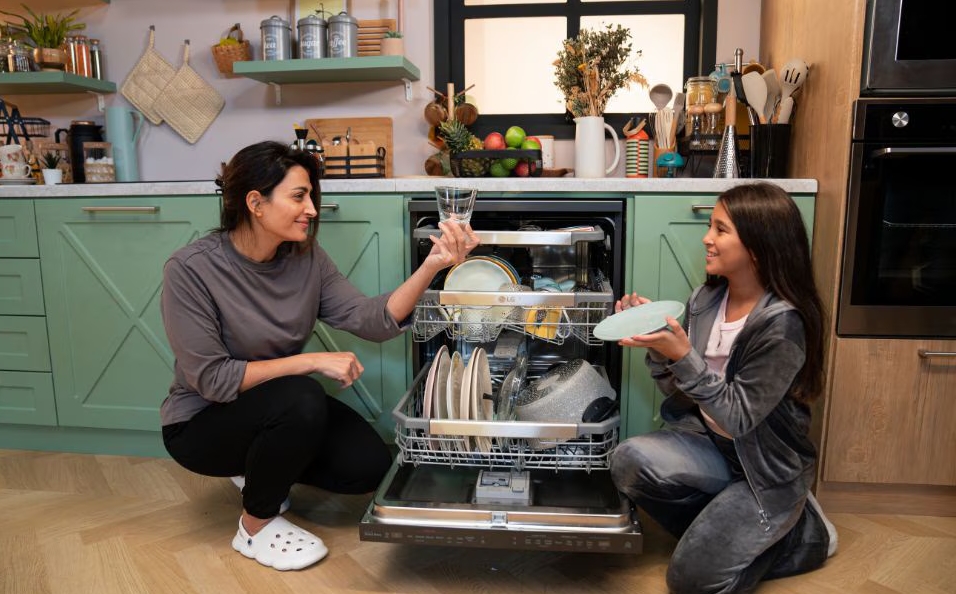When you discover a leak under your dishwasher door there’s an 85% chance it’s a dirty door seal that should only take 10 minutes to fix. As an appliance repair technician with more than three decades of experience, I’ve seen many dishwashers that eventually leak from the bottom corners of the door. I love receiving this repair request. It’s almost always caused by the same problem, and I can fix it within 10 minutes with a few supplies. Eventually, all dishwashers end up with a dribbling leak from the lower corner of the door. If left untreated, it can warp and discolor the kitchen floor — a costly repair. Here, I’ll share all the possible causes of a dishwasher door leak and some easy DIY fixes. When homeowners see this problem, they instinctively suspect the door seal has failed. In all my years of fixing dishwashers, I’ve never had to replace the bottom door seal. It’s easily fixed by thoroughly cleaning the door seal attached to the front of the dishwasher tub. All you need is a bowl of hot water, an old toothbrush and some liquid detergent.[mfn]From “Why Is Your Dishwasher Leaking From the Bottom of the Door?” by Scott Flint, Family Handyman, Feb 06, 2024[/mfn]
Common Causes of Dishwasher Leaks
A leaking dishwasher can be a headache that costs you time and energy, requiring you to do dishes by hand or to clean up regular puddles that appear on the floor. A dishwasher that leaks for too long can even be a threat to your home’s structural integrity and could lead to wood rot and other problems under the floor. Tired of dealing with your leaky dishwasher? Don’t let it become a bear of a problem! We’re here to help you tackle this issue head-on. Discover what’s causing the leak and how to fix it, so you can bear-ly worry about it anymore! Did you know your dishwasher has this cool filter that catches food bits? Super handy, right? But if it gets all jammed up with leftovers, your dishwasher might start spilling water everywhere instead of draining properly. That dishwasher door needs to seal up real snug, or you might end up with leaks while it’s doing its thing. Not a fun surprise! If you notice water leaking from the front of the dishwasher during a cycle, chances are the door is not sealed properly. It could be that the hinge is misaligned or the door isn’t latching closed properly, leaving an opening for water to sneak out.
Just a heads up: while it’s not super common, a defective or corroded tub could be the culprit behind your dishwasher leaking over time. If you spot any corrosion on the tub, that’s a telltale sign of what’s causing the issue. To get this sorted, it’s best to reach out to a trusted repair person for assistance. They’ll be able to assess the situation and recommend the necessary steps to fix the problem.[mfn]From “5 Causes For Dishwasher Leaks” by AAA Appliance Service Center, Feb 28, 2024[/mfn]
Dishwasher leaks can be attributed to multiple causes. If you’re unsure of where the leak is coming from, the following possibilities are a good start: Leaks caused by a damaged water supply line will typically be found underneath the unit. To find out if the leak is being caused by the water supply line, you’ll need to locate and inspect it. If your dishwasher is not filling with water, this a faulty water supply line may also be the cause. Turn off power to the appliance at the breaker or by unplugging it. Take off the lower kick panel by turning the fasteners. Remove the panel and sound insulation, making note of the installed orientation and position. Locate the water line hookup at the front left corner of the unit. Inspect the water connection and check the floor for dampness. Hand tighten the hose if needed until the coupling is tight. Using pliers, check the tightness of the coupling.
An unlevel dishwasher may cause water to overflow the tub and exit beneath the door. You will need to level out your dishwasher in order to stop the leak. Place a level against the top front of the unit to check if it is level. If it is not level, turn off power to the appliance. Remove the cabinet anchor screws. Take off the lower kick panel by turning the fasteners. Remove the panel and sound insulation, making note of the installed orientation and position. Adjust the leveling legs up or down until the unit is square in the cabinet and evenly supported by the rear wheels. Reinstall the cabinet anchor screws. Restore power to the appliance.[mfn]From “Leaking Dishwasher? 6 Common Causes & Fixes” by Whirlpool, Jun 07, 2022[/mfn]
Additional Factors Contributing to Leaks
Sometimes a dishwasher leaks because a large item, like a cookie tray, is loaded vertically, and the water coming out of the spray arm deflects and finds its way past the door seal. Simply removing the large item fixes this problem. Occasionally, a door leaks because a water fill valve is stuck in the on position. This causes water to enter the dishwasher, even when’s off or unplugged. If you open the dishwasher door and water pours out onto the floor, it’s probably the fill valve. The solution? Turn the water off under the sink and replace the fill valve.
Pinch the black rubber seal between your thumb and index finger and lightly pull it toward you about one-quarter inch. Add one teaspoon liquid detergent to a bowl of hot water. Scrub the entire length of the black rubber door seal with the toothbrush and the cleaning solution to remove debris. Wipe the seal with a wet paper towel. Dry the seal with new paper towels. The seal should now be clean and supple. Close the door and run a cycle for at least 10 minutes. If there’s no more leak, you’re done.
When it comes to modern kitchen appliances, dishwashers have undoubtedly become a household essential. They save time, energy, and make the tedious task of washing dishes an absolute breeze. However, one of the most perplexing issues homeowners face is a leaking dishwasher. It’s a problem that can range from a minor annoyance to a significant concern, potentially leading to costly repairs. In this comprehensive article, we will delve into the reasons behind a leaking dishwasher, help you troubleshoot the issue, and provide solutions to prevent future leaks. Before we dive into the specifics of why dishwashers leak, it’s essential to understand how these appliances work. Dishwashers are designed with multiple components that work in harmony to ensure efficient cleaning. Water Inlet Valve: Controls the flow of water into the machine. Pump and Motor: Circulates water during the wash and rinse cycles.
Additionally, the dishwasher’s pump may also be at fault. If the pump has failed or the seals around it have worn out, it can lead to leakage. A failed pump often results in pooling water at the bottom of the appliance. If you’ve checked the hose and filter and can’t find the source of the leak, it may be necessary to consult a professional technician to assess further and resolve any pump-related issues.[mfn]From “Unraveling the Mystery: Why Your Dishwasher is Leaking” by HomeGearGeek, Dec 06, 2024[/mfn]
Troubleshooting and Fixing the Problem
If you notice your dishwasher leaking, don’t risk major water damage to your floor or get stuck washing your dishes by hand; figure out if one of these five reasons is the culprit and fix it. Safety first: Before you start poking around the electrical components of your machine, make sure you unplug it and shut off power at the circuit breaker that controls the kitchen appliance. While you’re at it, make sure the water valve (located under the kitchen sink) is closed. Then, grab the user manual that came with your appliance or find a copy of the PDF online to get to know which part of your leaking dishwasher is giving your problems.
A failing gasket seal along the edge of the appliance’s door is one of the most common reasons for dishwasher leaks. When new and supple, its rubber material works well to keep water inside the machine—but it can dry out, become brittle, and crack after years of use. Dried foods can also build up along the gasket edge and prevent the door from closing tight against the frame. WHAT TO LOOK FOR: Water leaking from the sides of the dishwasher. On the interior floor your dishwasher, the spray arm spins during the wash and rinse cycles and sprays water onto the dishes. However, in an overcrowded or incorrectly loaded appliance, utensils and dishes may block the arm from rotating properly or cause it to become dislodged, even damaged after years of use, which leads to leaks.
WHAT TO LOOK FOR: A stuck or clogged spray arm. Open the dishwasher door, remove the lower dish rack, and spin the spray arm to see if it moves freely. If not, clear any obstructions like fallen silverware or residue build-up. Unscrew the spray arm counter-clockwise to remove it and inspect for damage such as cracks or blocked holes. THE FIX: Install the new spray arm. You can order a new one from the manufacturer and replace the defective arm yourself. First, unscrew the spray arm counter-clockwise if you haven’t already.
A float assembly consisting of a float and float switch are used to maintain the proper water level during the wash and rinse cycles. When your dishwasher runs, the float lifts with the rising water. When it reaches a certain height, it triggers the float switch to turn off the water. If the switch malfunctions, the water level will get too high and a leak could occur. WHAT TO LOOK FOR: Water levels above the heating element and/or no continuity at the float switch when tested with a multimeter. Open the door at mid-cycle to see what you’re dealing with. Water levels should be below the heating element; if not, you may need to replace the float switch.[mfn]From “5 Reasons Your Dishwasher Is Leaking (and How to Repair It)” by Bob Vila, Mar 29, 2020[/mfn]
Supplementary Information: Prevention and Maintenance
Regular maintenance is essential for preventing leaks in your dishwasher. By routinely checking and cleaning important components, such as the door seal, filter, and spray arms, you can reduce the likelihood of clogs and damage. Inspect the door gasket for wear and clean any debris that could prevent a proper seal. This simple task can avoid water from leaking during cycles and extend the lifespan of your appliance. Additionally, ensuring that the hoses are free of kinks and cracks can also prevent future leaks. It’s beneficial to periodically run a vinegar or baking soda rinse through the dishwasher to help clean out any built-up grime and maintain proper drainage.
Temporarily placing a towel or bucket to catch water can help mitigate damage until you can identify and fix the source of the leak. Don’t hesitate to consult a professional if you are unable to resolve the situation on your own, as they can provide appropriate diagnostics and repairs. Using a leaking dishwasher is not advisable as it can lead to more serious problems. Water leakage can cause damage to your kitchen floor, cabinetry, and other adjacent appliances. In the worst-case scenario, it could create an electrical hazard if water contacts any electrical components. Thus, it’s important to address the leak as soon as possible to prevent any further complications. If you find your dishwasher leaking, stop using it and investigate the issue.
Identifying the source of a leak in your dishwasher can be done with a systematic approach. First, observe where the water is pooling. If it’s near the base of the machine or directly underneath, then it’s likely coming from either the door seal or drainage hose. You can perform a visual inspection of the door seal for any signs of wear or damage. If you see water escaping from the door edges, that’s usually a clear indication that the seal needs replacement. Next, check the hoses connected to your dishwasher.
Another major cause of leaks is a clogged drain. When the drain is obstructed, water can back up and escape from the appliance. It’s also important to check the dishwasher’s spray arm; if it is blocked or misaligned, it can cause water to spray improperly, contributing to leaks. Regular maintenance can help identify these issues before they lead to significant problems.
FAQ
Q: Why is my dishwasher leaking from the bottom?
A: If your dishwasher is leaking from the bottom, explore this article to help diagnose the issue: A faulty gasket is one of the leading causes of a dishwasher dripping from the bottom. It’s located along the perimeter of the door and should produce a watertight seal when the door is closed. If the gasket becomes defective, dirty, or loose, it won’t seal properly. This could cause water to escape your appliance door during rinse cycles. What to do: We recommend checking the gasket for any deficiencies. This can be done by opening the appliance door and looking for any cracks, holes, or dirt. You’ll have to replace the gasket if it’s damaged or loose. If it’s just dirty, you can clean it with a cloth. A leaky dishwasher may be a sign that your water pump system is broken. It’s responsible for two things: carrying water to the wash cycle and releasing water out of the drain.[mfn]From “5 Causes of Why Your Dishwasher is Leaking from the Bottom” by Mr. Appliance, undated[/mfn]
Q: How do I know if the leak is coming from the water supply line?
A: Leaks caused by a damaged water supply line will typically be found underneath the unit. To find out if the leak is being caused by the water supply line, you’ll need to locate and inspect it. Turn off power to the appliance at the breaker or by unplugging it. Take off the lower kick panel by turning the fasteners. Remove the panel and sound insulation, making note of the installed orientation and position. Locate the water line hookup at the front left corner of the unit. Inspect the water connection and check the floor for dampness. Hand tighten the hose if needed until the coupling is tight. Using pliers, check the tightness of the coupling.
Q: Can using the wrong detergent cause a leak?
A: Using dishwashing soap instead of dishwasher detergent can result in excessive sudsing, causing leaks during wash cycles. Even if you consistently use dishwasher detergent, adding too much can also result in excessive suds and leaks. To avoid leaking it’s imperative to only use dishwasher detergent, not dishwashing liquid or other cleansers. When adding detergent, refer to the package instructions for the right amount and measure accurately to avoid oversudsing.[mfn]From “Solved: Why Is My Dishwasher Leaking Water?” by Solar Appliance, Mar 01, 2022[/mfn]
Q: What should I do if there’s water at the bottom of my dishwasher when not in use?
A: A clogged drain is typically the cause if there’s a pool of water at the bottom of your dishwasher. Food scraps, soap scum, and other grime can cause clogs that prevent water from draining properly. What to do: A good rule of thumb is to clean your filter frequently. Most can last up to five years with regular cleaning.
Q: Should I call a professional or try to fix it myself?
A: Don’t hesitate to consult a professional if you are unable to resolve the situation on your own, as they can provide appropriate diagnostics and repairs. If you’re not confident in your DIY plumbing skills, this fix, and all the following fixes, may be best addressed by a professional.

